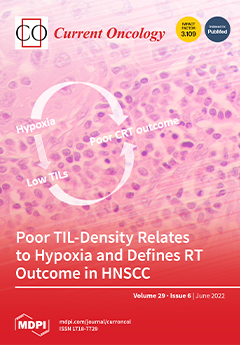Open AccessArticle
An Oncology Urgent Care Clinic for the Management of Immune-Related Adverse Events: A Descriptive Analysis
by
Kai-li Liang, Sean Tackett, Samantha Myers, Julie R. Brahmer, Ilene S. Browner, David S. Ettinger, Patrick M. Forde, Russell K. Hales, Christine L. Hann, Vincent K. Lam, Kristen A. Marrone, Tricia Patel, Valerie Peterson, Sarah Sagorsky, Michelle Turner, Khinh R. Voong, Jarushka Naidoo and Josephine L. Feliciano
Cited by 1 | Viewed by 2892
Abstract
Introduction: With the increasing use of immune checkpoint inhibitors (ICI) for cancer, there is a growing burden on the healthcare system to provide care for the toxicities associated with these agents. Herein, we aim to identify and describe the distribution of encounters seen
[...] Read more.
Introduction: With the increasing use of immune checkpoint inhibitors (ICI) for cancer, there is a growing burden on the healthcare system to provide care for the toxicities associated with these agents. Herein, we aim to identify and describe the distribution of encounters seen in an urgent care setting for immune-related adverse events (irAEs) and the clinical outcomes from irAE management. Methods: Patient demographics, disease characteristics, and treatment data were collected retrospectively from encounters at an oncology Urgent Care Clinic (UCC) from a single tertiary center for upper aerodigestive malignancies from 1 July 2018 to 30 June 2019. Data were summarized using descriptive statistics with odds ratios for associations between patient features and hospitalization after UCC evaluation. Results: We identified 494 encounters from 289 individual patients over the study period. A history of ICI therapy was noted in 34% (n = 170/494) of encounters and 29 encounters (29/170, 17%) were confirmed and treated as irAEs. For those treated for irAEs, the majority (n = 19/29; 66%) were discharged home. Having an irAE was associated with an increased risk of hospitalization compared to non-irAEs (OR 5.66; 95% CI 2.15–14.89;
p < 0.001). Conclusion: In this single institution experience, the majority of UCC encounters for confirmed irAEs were safely managed within the UCC. In ICI-treated patients, having an irAE was associated with an increased risk of hospitalization versus non-irAEs.
Full article
►▼
Show Figures






